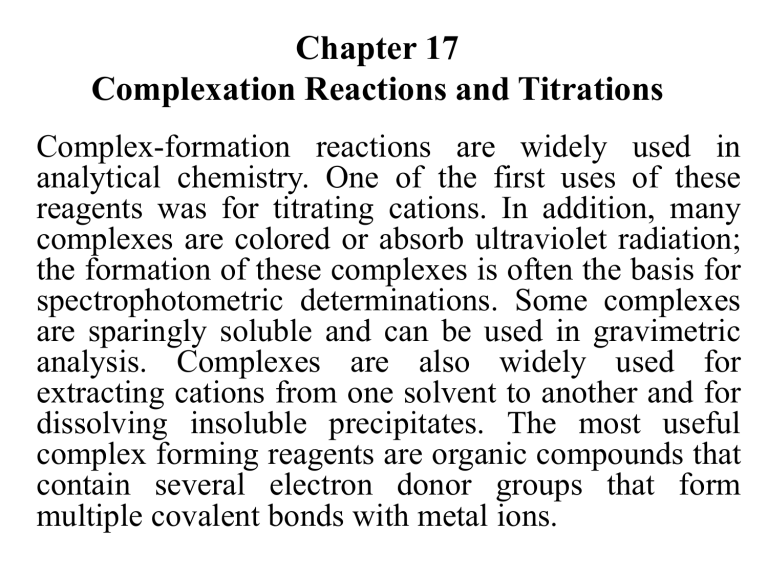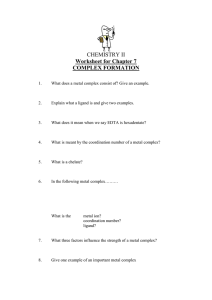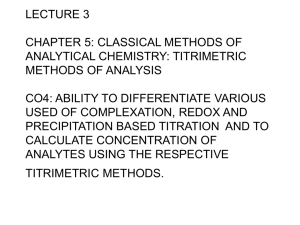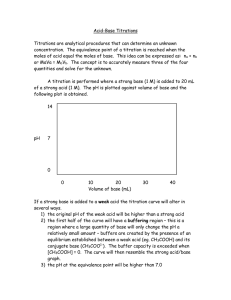Chapter 17 Complexation Reactions and Titrations

Chapter 17
Complexation Reactions and Titrations
Complex-formation reactions are widely used in analytical chemistry. One of the first uses of these reagents was for titrating cations. In addition, many complexes are colored or absorb ultraviolet radiation; the formation of these complexes is often the basis for spectrophotometric determinations. Some complexes are sparingly soluble and can be used in gravimetric analysis.
Complexes are also widely used for extracting cations from one solvent to another and for dissolving insoluble precipitates. The most useful complex forming reagents are organic compounds that contain several electron donor groups that form multiple covalent bonds with metal ions.
FORMING COMPLEXES
Most metal ions react with electron-pair donors to form coordination compounds or complexes. The donor species, or ligand is an ion or a molecule that forms a covalent bond with a cation or a neutral metal atom by donating a pair of electrons that are then shared by the two.
The number of covalent bonds that a cation tends to form with electron donors is its coordination number. Typical values for coordination numbers are two, four, and six. The species formed as a result of coordination can be electrically positive, neutral, or negative.
A ligand that has a single donor group, such as ammonia, is called unidentate (single-toothed), whereas one such as glycine, which has two groups available for covalent bonding, is called bidenate .
Tridentate , tetradentate , pentadentate , and hexadentate chelating agents are also known.
Another important type of complex, a macrocycle , is formed between a metal ion and a cyclic organic compound. The selectivity of a ligand for one metal ion over another relates to the stability of the complexes formed. The higher the formation constant of a metal-ligand complex, the better the selectivity of the ligand for the metal relative to similar complexes formed with other metals.
Producing Soluble Compelxes
Complexation reactions involve a metal ion M reacting with a ligand L to form a complex ML.
M + L ML
Complexation reactions occur in a stepwise fashion, and the reaction above is often followed by additional reactions:
ML + L
ML
2
+ L
ML
ML
3
2
ML n-1
+ L ML n
Unidentate ligands invariably add in a series of steps. With multidentate ligands, the maximum coordination number of the cation may be satisfied with only one or a few added ligands.
…continued…
The equilibrium constants for complex formation reactions are generally written as formation constants.
M + 2L ML
2
M + 3L ML
3
M + nL ML n
2
ML
2
2
3
ML
3
3
K K
2
K K K
3
n
ML n
n
K K
2
....
K n
The overall formation constants are products of the stepwise formation constants for the individual steps leading to the product.
Forming Insoluble Species
The addition of ligands to a metal ion may result in insoluble species, such as the familiar nickeldimethylglyoxime precipitate. In many cases, the intermediate uncharged complexes in the stepwise formation scheme may be sparingly soluble, whereas the addition of more ligand molecules may result in soluble species. AgCl is insoluble, but addition of large excess of Cl produces soluble
AgCl
2
, AgCl
3
2, and AgCl
4
3.
…continued…
In contrast to complexation equilibria, which are most often treated as formation reactions, solubility equilibria are usually treated as dissociation reactions
M x
A y
(s) xM
K sp
= [M y+ ] x [A x] y y+ (aq) + yA x(aq) where, K sp
= solubility product. Hence, for BiI
3 solubility product is written K sp
= [Bi 3+ ][I ] 3 .
, the
The formation of soluble complexes can be used to control the concentration of free metal ions in solution and thus control their reactivity.
TITRATION WITH INORGANIC
COMPLEXING AGENTS
Complexation reactions have many uses in analytical chemistry, but their classical application is in complexometric titrations. Here, a metal ion reacts with a suitable ligand to form a complex, and the equivalence point is determined by an indicator or a suitable instrumental method. The formation of soluble inorganic complexes is not widely used for titration but the formation of precipitates is the basis for many important determinations.
Complexation Titrations
The progress of a complexometric titration is generally illustrated by a titration curve, which is usually a plot of pM = -log[M] as a function of the volume of titrant added.
Most often in complexometric titrations the ligand is the titrant and the metal ion the analyte, although occasionally the reverse is true. Many precipitation titrations use the metal ion as the titrant. Most simple inorganic ligands are unidentate, which can lead to low complex stability and indistinct titration end points.
…continued…
As titrants, multidentate ligands, particularly those having four or six donor groups, have two advantages over their unidentate counterparts.
First , they generally react more completely with cations and thus provide sharper end points.
Second , they ordinarily react with metal ions in a single-step process, whereas complex formation with unidentate ligands usually involves two or more intermediate species.
Precipitation Titratons (Chapter 13)
Precipitation titrimetry, which is based on reactions that yield ionic compounds of limited solubility, is one of the oldest analytical techniques. The slow rate of formation of most precipitates, however, limits the number of precipitating agents that can be used in titrations to a handful. The most widely used and important precipitating reagent, silver nitrate, which is used for the determination of the halogens, the halogen-like anions. Titrations with silver nitrate are sometimes called argentometric titrations .
The Shapes of Titration Curves
Titration curves for precipitation reactions are derived in a completely analogous way to the methods described for titrations involving strong acids and strong bases. P-functions are derived for the preequivalence-point region, the postequivalence point region, and the equivalence point for a typical precipitation titraton.
Most indicators for argentometric titrations respond to changes in the concentration of silver ions. As a consequence, titraton curves for precipitation reactions usually consist of a plot of pAg versus volume of AgNO
3
.
End Point for Argentometric Titrations
Three types of end points are: (1) chemical, (2) potentiometric, (3) amperometric. Potentiometric end points are obtained by measuring the potential. To obtain an amperometric end point, the current generated between a pair of silver microelectrodes is measured and plotted as a function of reagent volume.
The chemical end point consists of a color change or the appearance or disappearance of turbidity. The requirements are (1) the color change should occur over a limited range in the p-function, and (2) the color change should take place within the steep portion of the titration curve.
Formation of a Colored Precipitate
The Mohr Method
Sodium chromate can serve as an indicator for the argentometric determination of chloride, bromide, and cyanide ions by reacting with silver ion to form a brick-red silver chromate (Ag
2
CrO
4
) precipitate in the equivalencepoint region. The reactions involved in the determination of chloride and bromide (X ) are titration reaction: Ag + + X indicator reaction: 2Ag + + CrO
4
2-
AgX
(s)
[white]
Ag
2
CrO
4(s)
[red]
The solubility of silver chromate is several times grater than that of silver chloride or silver bromide.
Adsorption Indicators: The Fajans Method
An adsorption indicator is an organic compound that tends to be adsorbed onto the surface of the solid in a precipitation titration. Ideally, the adsorption occurs near the equivalence point and results not only in a color change but also in a transfer of color from the solution to the solid (or the reverse).
Fluorescein is a typical adsorption indicator useful for the titration of chloride ion with silver nitrate. In aqueous solution, fluorescein partially dissociates into hydronium ions and negatively charged fluoresceinate ion that are yellow-green. The fluoresceinate ion forms an intensely red silver salt. Titrations involving adsorption indicators are rapid, accurate, and reliable.
The Volhard Method (Colored Complex)
In the Volhard method, silver ions are titrated with a standard solution of thiocyanate ion:
Ag + + SCN AgSCN(s)
Iron (III) serves as the indicator. The solution turns red with the first slight excess of thiocyanate ion:
Fe 3+ + SCN Fe(SCN) 2+ red
K f
Fe SCN )
2+
Fe
3+
SCN
.
3
105 10
The titration must be carried out in acidic solution to prevent precipitation of iron (III) as the hydrated oxide.
…continued…
The most important application of the Volhard method is for the indirect determination of halide ions. A measured excess of standard silver nitrate solution is added to the sample, and the excess silver ion is determined by back-titration with a standard thiocyanate solution.
ORGANIC COMPLEXING AGENTS
(Chapter 17)
Many different organic complexing agents have become important in analytical chemistry because of their inherent sensitivity and potential selectivity in reacting with metal ions. Such reagents are particularly useful in precipitating metal and in extracting metal from one solvent to another. The most useful organic reagents form chelate complexes with metal ions.
Reagents for Precipitating Metals
One important type of reaction involving an organic complexing agent is that in which an insoluble, uncharged complex is formed. Usually, it is necessary to consider stepwise formation of soluble species in addition to the formation of the insoluble species. Thus, a metal ion M n+ reacts with a complexing agent X to form MX (n-1)+ , MX
2
(n-2)+ , MX n-1
+ , and MX n
(soln).
M n+ + nX MX n
(soln)
n
M
MX n n+
X
-
n
K K
2
....
K n
MX n
(solid) MX n
(soln)
Solubility product expression is:
K sp
= [M n+ ][X ] n = K eq
/
n
K eq
= [MX n
]
Forming Soluble Complexes for Extractions
Many organic reagents are useful in converting metal ions into form that can be readily extracted from water into an immiscible organic phase.
Extraction are widely used to separate metals of interest from potential interfering ions and for achieving a concentrating effect by extracting into a phase of smaller volume. Extractions are applicable to much smaller amounts of metals than precipitations, and they avoid problems associated with coprecipitation.
Ethylenediaminetetraacetic Acid (EDTA)
Ethylenediaminetetraacetic acid [also called
(ethylenedinitrilo)tetraacetic acid], which is commonly shortened to EDTA, is the most widely used complexometric titrant. Fully protonated EDTA has the structure
The EDTA molecule has six potential sites for bonding a metal ion: the four carboxyl groups and the two amino groups, each of the latter with an unshared pair of electrons. Thus, EDTA is a hexadentate ligand.
EDTA Is a Tetrabasic Acid
The dissociation constants for the acidic groups in
EDTA are K
6.92 X 10 -7
1
= 1.02 X 10 -2 , K
2
, and K
4
= 2.14 X 10 -3 , K
3
=
= 5.50 X 10 -11 . It is of interest that the first two constants are of the same order of magnitude, which suggests that the two protons involved dissociate from opposite ends of the long molecule. As a consequence of their physical separation, the negative charge created by the first dissociation does not greatly affect the removal of the second proton. The various EDTA species are often abbreviated H
4
Y, H
3
Y , H
2
Y 2, HY 3, and Y 4.
Reagents for EDTA Titrations
The free acid H
4
Y and the dihydrate of the sodium salt, Na
2
H
2
Y.2H
2
O, are commercially available in reagent quality.
Under normal atmospheric conditions, the dihydrate,
Na
2
H
2
Y.2H
2
O, contains 0.3% moisture in excess of the stoichiometric amount.
This excess is sufficiently reproducible to permit use of a corrected weight of the salt in the direct preparation of a standard solution. The pure dihydrate can be prepared by drying at 80 o C for several days in an atmosphere of 50% relative humidity.
Nitrilotriacetic acid (NTA)
The Nature of EDTA Complexes with Metal Ions
Solutions of EDTA are valuable as titrants because the reagent combines with metal ions in a 1:1 ratio regardless of the charge on the cation.
Ag + + Y 4AgY 3-
Al 3+ + Y 4AlY -
EDTA is a remarkable reagent not only because it forms chelates with all cation but also because most of these chelates are sufficiently stable for titrations. This great stability undoubtedly results from the several complexing sites within the molecule that give rise to a cagelike structure in which the cation is effectively surrounded and isolated from solvent molecules. The ability of EDTA to complex metals is responsible for its widespread use as a preservative in foods and in biological samples.
Indicators for EDTA Titrations
Indicators are organic dyes that form colored chelates with metal ions in a pM range that is characteristic of the particular cation and dye. The complexes are often intensely colored and are discernible to the eye at concentrations in the range of 10 -6 to 10 -7 M.
Eriochrome Black T is a typical metal-ion indicator used in the titration of several common cations.
H
2
O + H
2
In red
HIn 2blue
+ H
3
O + K
1
= 5 X 10 -7
H
2
O + HIn 2blue
In 3+ H
3
O + orange
K
2
= 2.8 X 10 -12
The acids and their conjugate bases have different colors.
…continued…
The metal complexes of Eriochrome Black T are generally red, as is H
2
In . Thus, for metal-ion detection, it is necessary to adjust the pH to 7 or above so that the blue form of the species, HIn 2, predominates in the absence of a metal ion. Until the equivalence point in a titration, the indicator complexes the excess metal ion so that the solution is red. With the first slight excess of EDTA, the solution turns blue as a consequence of the reaction
MIn + HY 3HIn 2+ MY 2red blue
Titration Methods Employing EDTA
Direct Titration: Many of the metals in the periodic table can be determined by titration with standard EDTA solution. Some methods are based on indicators that respond to the analyte itself, whereas others are based on an added metal ion.
Methods Based on Indicators for an Added metal Ion: In case where a good, direct indicator for the analyte is unavailable, a small amount of a metal ion for which a good indicator is available can be added. The metal ion must form a complex that is less stable than the analyte complex.
…continued…
Potentionmetric Methods: Potential measurements can be used for end-point detection in the EDTA titration of those metal ion for which specific ion electrodes are available.
Spectrophotometric Methods: Measurement of
UV/visible absorption can also be used to determine the end points of titrations. In these cases, an instrument responds to the color change in the titration rather than relying on a visual determination of the end point.
…continued…
Back-Titration Methods: Back-titrations are useful for the determination of cations that form stable EDTA complexes and for which a satisfactory indicator is not available; the determination of thallium is an extreme example.
The method is also useful for cations such as
Cr(III) and Co(III) that react only slowly with
EDTA. A measured excess of standard EDTA solution is added to the analyte solution. After the reaction is judged complete, the excess EDTA is back-titrated with a standard magnesium or zinc ion solution to an Eriochrome Black T or
Calmagite end point.
…continued…
Displacement methods: In displacement titrations, an unmeasured excess of a solution containing the magnesium or zinc complex of EDTA is introduced into the analyte solution. If the analyte forms a more stable complex than that of magnesium or zinc, the following displacement reaction occurs:
MgY 2+ M 2+ MY 2+ Mg 2+ where M 2+ represents the analyte cation. The liberated Mg 2+ or, in some cases Zn 2+ is then titrated with a standard EDTA solution. Displacement titrations are used when no indicator for an analyte is available.






